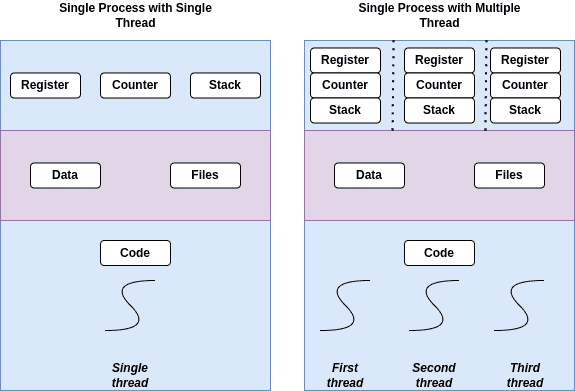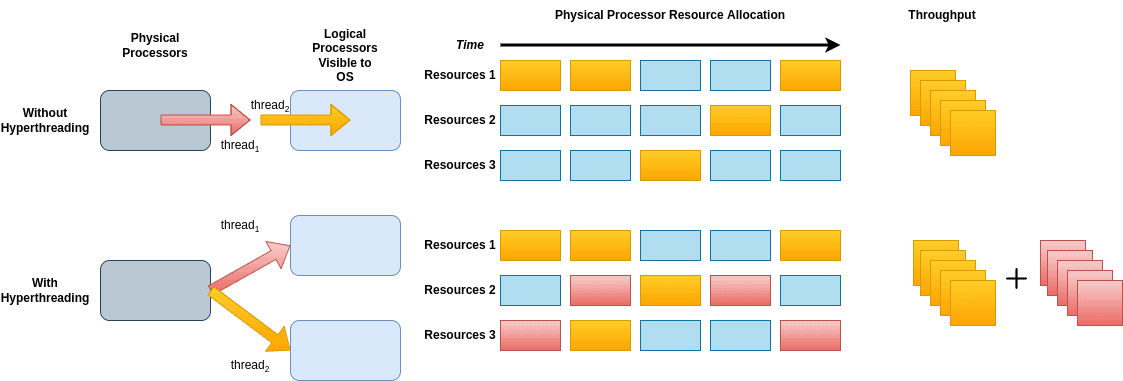1. 简介
在计算机系统中,提升性能和响应速度是永恒的话题。本文将深入探讨两种关键技术:Multithreading(多线程) 和 Hyperthreading(超线程)。我们会从它们的工作原理、实现方式、优缺点以及适用场景等方面进行对比分析。
2. Multithreading(多线程)
多线程是操作系统中一种并发执行机制,它将一个程序划分为多个线程(Thread),这些线程可以并行执行以提升程序的效率和响应能力。
✅ 优势:
- 提高系统吞吐量
- 更好地利用 CPU 资源
- 支持并发处理多个任务
❌ 缺点:
- 需要处理线程同步问题(如死锁、竞态条件)
- 线程之间共享内存,容易引发数据不一致问题
多线程可以分为两种类型:
- 内核级线程(Kernel Threads):由操作系统直接支持,线程切换开销大但更稳定
- 用户级线程(User Threads):由线程库实现,创建和切换更快,但对系统调度不透明
下图展示了典型的多线程架构:

3. Hyperthreading(超线程)
超线程是由 Intel 在 2002 年推出的一项硬件技术,其核心思想是将一个物理 CPU 核心虚拟化为两个逻辑核心,从而让操作系统认为系统中有更多的 CPU 可用。
✅ 优势:
- 提高 CPU 利用率
- 减少线程等待时间
- 不需要额外编程支持
❌ 缺点:
- 实际性能提升有限(通常在 10%-30%)
- 多线程负载下可能引起资源争抢(如缓存抖动)
下图展示了超线程的架构示意:

通过超线程技术,每个物理核心可以同时处理两个线程,操作系统将其识别为两个独立的“逻辑 CPU”。
4. Multithreading 与 Hyperthreading 的对比
| 特性 | Multithreading | Hyperthreading |
|---|---|---|
| 定义 | 同一进程中多个线程并发执行 | 单个物理核心模拟为多个逻辑核心 |
| 资源共享 | 每个线程有独立的执行资源 | 多个线程共享同一个物理核心资源 |
| 实现方式 | 软件或硬件实现 | 纯硬件实现 |
| 硬件需求 | 需要多个物理核心 | 单个核心即可 |
| 编程难度 | 高,需处理同步、死锁等问题 | 低,操作系统自动调度 |
⚠️ 注意:Hyperthreading 并不能真正替代 Multithreading,它只是在硬件层面优化了线程调度。
5. 优缺点对比
Multithreading
✅ 优点:
- 提供更强的并行计算能力
- 更适合需要大量 CPU 资源的任务(如图像处理、大数据分析)
❌ 缺点:
- 线程管理复杂,开发成本高
- 多线程间资源共享容易引发并发问题
Hyperthreading
✅ 优点:
- 提升 CPU 利用率
- 无需额外编程,对开发者透明
❌ 缺点:
- 性能提升有限
- 高并发场景下可能导致资源争抢(如缓存抖动)
6. 典型应用场景
Multithreading 常见用途:
- GUI 程序(如 Java Swing、Android)
- 网络请求处理(如 Web 服务器)
- 文件 I/O 操作
- 图像处理(如 Photoshop)
Hyperthreading 常见用途:
- 视频剪辑(如 Adobe Premiere)
- 3D 渲染(如 Blender)
- 科学计算与仿真(如 MATLAB、ANSYS)
📌 建议:在选择使用哪种技术时,应根据任务类型、CPU 架构以及系统资源综合判断。
7. 总结
- Multithreading 是软件层面的并发机制,适合需要高并发和并行处理的场景
- Hyperthreading 是硬件层面的优化技术,主要用于提升单核 CPU 的利用率
- 两者各有优势,合理结合使用可以在性能与资源之间取得最佳平衡
在实际开发中,Hyperthreading 是操作系统自动识别和调度的,而 Multithreading 则需要开发者主动设计和管理线程。因此,对于高级程序员来说,掌握多线程编程是提升系统性能的关键技能之一。